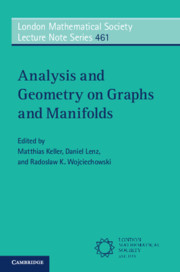Book contents
- Frontmatter
- Contents
- List of Contributors
- Preface
- 1 Infinite Planar Graphs with Non-negative Combinatorial Curvature
- 2 Curvature Calculations for Antitrees
- 3 Gromov–Lawson Tunnels with Estimates
- 4 Norm Convergence of the Resolvent for Wild Perturbations
- 5 Manifolds with Ricci Curvature in the Kato Class: Heat Kernel Bounds and Applications
- 6 Multiple Boundary Representations of λ-Harmonic Functions on Trees
- 7 Internal DLA on Sierpinski Gasket Graphs
- 8 Universal Lower Bounds for Laplacians on Weighted Graphs
- 9 Critical Hardy Inequalities on Manifolds and Graphs
- 10 Neumann Domains on Graphs and Manifolds
- 11 On the Existence and Uniqueness of Self-Adjoint Realizations of Discrete (Magnetic) Schrödinger Operators
- 12 Box Spaces: Geometry of Finite Quotients
- 13 Ramanujan Graphs and Digraphs
- 14 From Partial Differential Equations to Groups
- 15 Spectral Properties of Limit-Periodic Operators
- 16 Uniform Existence of the IDS on Lattices and Groups
6 - Multiple Boundary Representations of λ-Harmonic Functions on Trees
Published online by Cambridge University Press: 14 August 2020
- Frontmatter
- Contents
- List of Contributors
- Preface
- 1 Infinite Planar Graphs with Non-negative Combinatorial Curvature
- 2 Curvature Calculations for Antitrees
- 3 Gromov–Lawson Tunnels with Estimates
- 4 Norm Convergence of the Resolvent for Wild Perturbations
- 5 Manifolds with Ricci Curvature in the Kato Class: Heat Kernel Bounds and Applications
- 6 Multiple Boundary Representations of λ-Harmonic Functions on Trees
- 7 Internal DLA on Sierpinski Gasket Graphs
- 8 Universal Lower Bounds for Laplacians on Weighted Graphs
- 9 Critical Hardy Inequalities on Manifolds and Graphs
- 10 Neumann Domains on Graphs and Manifolds
- 11 On the Existence and Uniqueness of Self-Adjoint Realizations of Discrete (Magnetic) Schrödinger Operators
- 12 Box Spaces: Geometry of Finite Quotients
- 13 Ramanujan Graphs and Digraphs
- 14 From Partial Differential Equations to Groups
- 15 Spectral Properties of Limit-Periodic Operators
- 16 Uniform Existence of the IDS on Lattices and Groups
Summary
We consider a countable tree $T$, possibly having vertices with infinite degree, and an arbitrary stochastic nearest neighbour transition operator $P$. We provide a boundary integral representation for general eigenfunctions of $P$ with eigenvalue $\lambda \in \C$, under the condition that the oriented edges can be equipped with complex-valued weights satisfying three natural axioms. These axioms guarantee that one can construct a $\lambda$-Poisson kernel. The boundary integral is with respect to distributions, that is, elements in the dual of the space of locally constant functions. Distributions are interpreted as finitely additive complex measures. In general, they do not extend to $\sigma$-additive measures: for this extension, a summability condition over disjoint boundary arcs is required. Whenever $\lambda$ is in the resolvent of $P$ as a self-adjoint operator on a naturally associated $\ell^2$-space and the diagonal elements of the resolvent (“Green function”) do not vanish at $\lambda$, one can use the ordinary edge weights corresponding to the Green function and obtain the ordinary $\la$-Martin kernel.
We then consider the case when $P$ is invariant under a transitive group action. In this situation, we study the phenomenon that in addition to the $\lambda$-Martin kernel, there may be further choices for the edge weights which give rise to another $\lambda$-Poisson kernel with associated integral representations. In particular, we compare the resulting distributions on the boundary.
The material presented here is closely related to the contents of our “companion” paper\cite{PiWo}.
Keywords
- Type
- Chapter
- Information
- Analysis and Geometry on Graphs and Manifolds , pp. 95 - 125Publisher: Cambridge University PressPrint publication year: 2020



